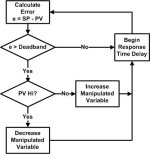Hey everyone, I am a student working on a control system senior project and could use some help.
I am working to maintain a dissolved oxygen setpoint with three possible ways to influence the value. The outputs are agitator speed(200-700rpm), air flow in(1slm-10slm), air/o2 concentration(30-100%).
I am doing this in Studio 5000 without PIDE(will need IT to add it to student package if its a better solution).
The process typically done is to set agitation to the 200 min, set air flow(30% o2 concentration) to 1 slm and then the 35% Dissolved oxygen set point. As the cells consume oxygen, the agitation can be increased to a max of 700 before bumping up the air flow.
If the DO setpoint can be achieved with just agitation control then airflow and concentration should not vary.
Sorry for the long background. My current idea is to only focus on one PID( DO vs speed)then when the max speed is reached bump the air flow .5 slm at a time and return to the PID. Expected result is a speed decrease. Air concentration would just be randomly changed if flow and agitation remain high.
I feel like i am not utilizing the PID to its potential. So in conclusion, how could I go about optimizing those 3 values while achieving desired setpoint.?
I am working to maintain a dissolved oxygen setpoint with three possible ways to influence the value. The outputs are agitator speed(200-700rpm), air flow in(1slm-10slm), air/o2 concentration(30-100%).
I am doing this in Studio 5000 without PIDE(will need IT to add it to student package if its a better solution).
The process typically done is to set agitation to the 200 min, set air flow(30% o2 concentration) to 1 slm and then the 35% Dissolved oxygen set point. As the cells consume oxygen, the agitation can be increased to a max of 700 before bumping up the air flow.
If the DO setpoint can be achieved with just agitation control then airflow and concentration should not vary.
Sorry for the long background. My current idea is to only focus on one PID( DO vs speed)then when the max speed is reached bump the air flow .5 slm at a time and return to the PID. Expected result is a speed decrease. Air concentration would just be randomly changed if flow and agitation remain high.
I feel like i am not utilizing the PID to its potential. So in conclusion, how could I go about optimizing those 3 values while achieving desired setpoint.?





